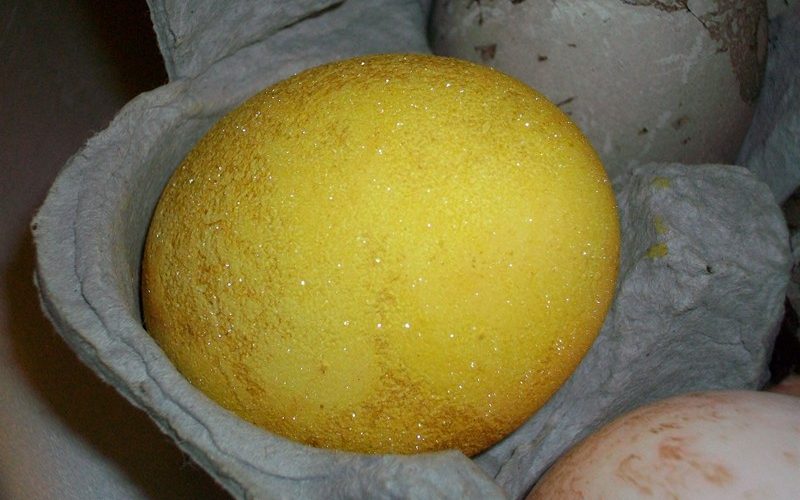
Staff Photo Amanda Bancroft
Cream of tartar combined with turmeric in a boiling water bath created this sparkly yellow egg. No glitter was used! But natural egg dyes bring mixed results, and the other eggs looked more appropriate for Halloween than Easter, so experiment beforehand.
Spring is here, and signs of new life are everywhere. Farms are abundant with baby pigs, calves, chicks and ponies.
The woods are twittering with songbird nestlings, fawns are about to bound into existence, and fuzzy baby predators of all sorts are waiting to be nourished by the sacrifice of baby prey animals. In the human world, some try to make the season more humane or healthy in various ways. From alternatives to eggs to natural egg dye, from fair trade chocolate to locally produced treats, there are plenty of ways to choose your impact and go for it! If money is a problem, choose some of the free options mentioned here, or buy fewer but still ethical products (whether local, fair trade, vegan, etc.) to compensate for the insanely cheap prices that mainstream companies achieve through unethical practices and mass distribution.
Forgoing eggs entirely is an option vegans might prefer, which could mean a lot of family fun decorating “forever” eggs made from craft supplies and covered in glitter or decoupage flowers. Some egg ornaments are made from real egg shells that are gently painted and preserved for generations. Wood, marble, plastic, or stone eggs can be surprisingly attractive. Eggs made from moss, stones and other compostable materials will last only for awhile, but are free to gather and create. And children will love going on a “real” Easter Egg Hunt in nature – see how many birds’ nests you can find, count the eggs and quickly photograph them, then go to NestWatch.org to identify your birds and report their hatching progress to scientists at the Cornell Lab of Ornithology. Do not touch or remove eggs, birds, or empty nests because it’s illegal and can harm certain birds.
If you love dyeing eggs, though, you could buy local sustainably-farmed eggs and try going with natural egg dye (results vary). Everyone’s doing it, even Martha Stewart and Fox News! Ingredients like hibiscus, beets, turmeric and grape juice are used because of their staining effect. One cup grape juice combined with 1 tablespoon white vinegar has worked for some people. Rubbing vegetable oil on the eggs after they’ve been dyed and dried gives them a finished shine. Online eco-egg dye kits might give better results than a DIY approach, but buy them early in the spring as they tend to be hard to find.
If chocolate eggs are more your thing, fair trade chocolate eggs help the environment, farmers, and workers – and dark chocolate is often vegan, too! Try brands like Divine, Sweet Earth Chocolates, Sjaak, or Equal Exchange. But honestly, local stores and the internet are full of so many options you might want to search around and try a few. No matter how you choose to make an “eggsellent” difference, have a tasty and fun spring!
Amanda Bancroft is a writer, artist, and naturalist building an off-grid cottage for land conservation on Mt. Kessler. She and her husband Ryan blog about their adventures and offer a solar-hosted online educational center on how to make a difference with everyday choices at: www.RipplesBlog.org.










